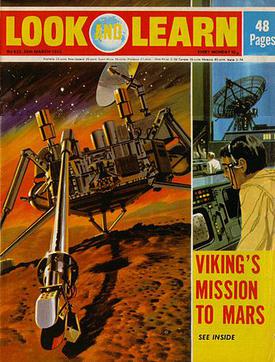
Look and Learn was a British weekly educational magazine for children published by Fleetway Publications Ltd from 1962 until 1982. It contained educational text articles that covered a wide variety of topics from volcanoes to the Loch Ness Monster; a long running science fiction comic strip, The Trigan Empire; adaptations of famous works of literature into comic-strip form, such as Lorna Doone; and serialized works of fiction such as The First Men in the Moon.
Jackpot was a British comic book magazine that ran from the issues cover dated 5 May 1979 to issue 141, 30 January 1982, when it merged with Buster.

Cuddles and Dimples is a British comic strip published in the comic book magazine The Dandy. It was first published in 1986. The stories' protagonists are two toddler brothers who like to cause double the trouble wherever they go. The artist when the strip first started was Barrie Appleby, who continued until 2004 with a strip by Gordon Bell in the 1994 annual and a sole strip by Nigel Parkinson in 2003, who took over the strip next year as part of the revamp at that time.

Donald Southam Lawrence was a British comic book artist and author.
Sweeny Toddler was a British comic strip by Leo Baxendale, which originally appeared in the British magazines Shiver and Shake, Whoopee!, Whizzer and Chips and finally Buster between 1973 and 2000. It was a gag-a-day about a little mischievous toddler. The name is a play on Sweeney Todd.
Faceache was a comic strip appearing in British comics in the 1970s and 1980s. He was created by Ken Reid.
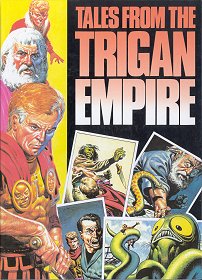
The Rise and Fall of the Trigan Empire, later shortened to The Trigan Empire, was a science fiction comic series written mainly by Mike Butterworth with artwork by Don Lawrence, among others. It told the story of an alien culture in which futuristic technology, such as antigravity vehicles and energy ray weapons, was blended with architecture, dress, and customs reminiscent of ancient civilizations, the most obvious being those of Ancient Greece and Rome. The stories revolved around a strong and heroic leader who defended his empire from constant threats from both outside and within. The comic featured unique artwork by Don Lawrence in a painterly photo-realistic style.
Frank Bellamy was a British comics artist, best known for his work on the Eagle comic, for which he illustrated Heros the Spartan and Fraser of Africa. He reworked its flagship Dan Dare strip.
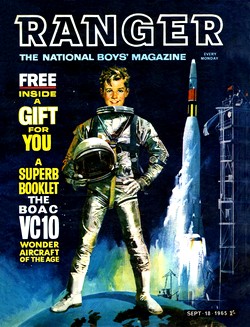
Ranger was a weekly British comics periodical published by Fleetway Publications from 18 September 1965 to 18 June 1966. Intended as an educational publication, the cover described it as "The National Boys' Magazine" and the content mixed comic strips with a much larger quotient of factual articles than most other Fleetway children's titles of the time. Ranger lasted 40 issues before being merged with Fleetway's fellow educational title Look and Learn in 1966.
TV Comic was a British comic book magazine published weekly from 9 November 1951 until 29 June 1984. Featuring stories based on television series running at the time of publication, it was the first British comic to be based around TV programmes; it spawned a host of imitators.
Scorcher was the name of a football-themed British comic magazine published by IPC between January 1970 and October 1974. Scorcher featured various well-known comic strips, such as Billy's Boots, Bobby of the Blues and Lags Eleven, a story about a prison football team. In addition, the Nipper strip was absorbed from the Score comic, and Hot Shot Hamish made its first appearance after that. Some of these stories later found homes in Roy of the Rovers and in Tiger.
TV Century 21, later renamed TV21, TV21 and Tornado, TV21 and Joe 90, and TV21 again, was a weekly British children's comic published by City Magazines during the latter half of the 1960s. Originally produced in partnership with Gerry and Sylvia Anderson's Century 21 Productions, it promoted the company's many science-fiction television series. The comic was published in the style of a newspaper of the future, with the front page usually dedicated to fictional news stories set in the worlds of Fireball XL5, Stingray, Thunderbirds, Captain Scarlet and the Mysterons and other stories. The front covers were also in colour, with photographs from one or more of the Anderson series or occasionally of the stars of the back-page feature.

Vulcan was a British weekly boys' comic published by IPC Magazines from 1 March 1975 to 3 April 1976, when it merged with Valiant. The comic was unusual among IPC's weeklies for several reasons - it used a much smaller format than most of the company's weeklies and featured more colour; until September 1975 the title was only available in Scotland as the format was tested; and it consisted entirely of reprints of extant material. It was also published simultaneously in German as Kobra.
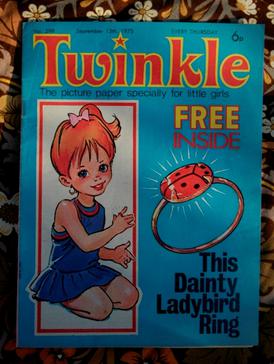
Twinkle, "the picture paper specially for little girls," was a popular British comics magazine, published by D. C. Thomson & Co. Ltd from 27 January 1968 to 1999. It was aimed at young girls and came out weekly, supplemented each year with a Summer Special and a hardcover Annual.
All the Asterix stories, created by René Goscinny and Albert Uderzo, have been translated into English. The vast majority of the albums were translated by Anthea Bell and Derek Hockridge. Their first volume, Asterix the Gaul, was published by Brockhampton Press in 1969. Bell retired in 2016 due to ill health and died in 2018; Hockridge died in 2013. Adriana Hunter currently serves as translator, with Asterix and the Chariot Race being her debut.
This is a list of Dalek comic strips, illustrated annuals and graphic novels. Cameo appearances and reprints are only covered if notable.
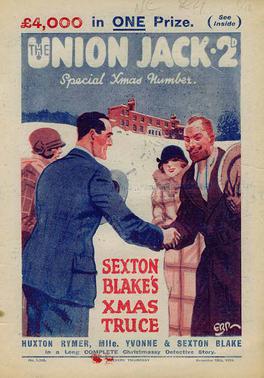
Eric Robert Parker was a prolific British illustrator and comics artist best known for illustrating the adventures of Sexton Blake in various periodicals.
Leonard James Matthews was a British editor, publisher, writer and illustrator of comics and children's magazines, best known as the founder of the educational magazine Look and Learn.
First Doctor comic stories refers to the comic strips devoted to the long-running British science fiction television series Doctor Who, using the likeness of the First Doctor William Hartnell. The strip was launched in Polystyle's TV Comic on 14 November 1964, less than a year after the television series began broadcasting and was the first original spin-off media from the show. This strip began what has become known as the 'Polystyle era': running from 1964 to 1979. The First Doctor starred in this strip running parallel with his appearance on the television show, ending in December 1966, after which TV Comic began creating strips for the Second Doctor. The franchise to print a regular comic strip passed to Doctor Who Magazine in 1979, and was opened up to multiple franchises in the mid-2000s. During this time, the First Doctor has made various guest appearances as well as starring in some one-off comic strips.
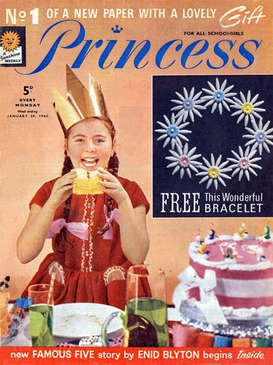
Princess was a British weekly girls' comic anthology published by Fleetway Publications and, later, IPC Magazines. The first version was published between 30 January 1960 and 16 September 1967, and featured a mix of comic strips, text stories and a large proportion of features; it was merged with Tina to form a new title - Princess Tina - after 399 issues.








